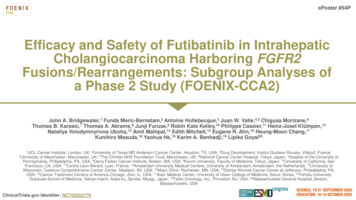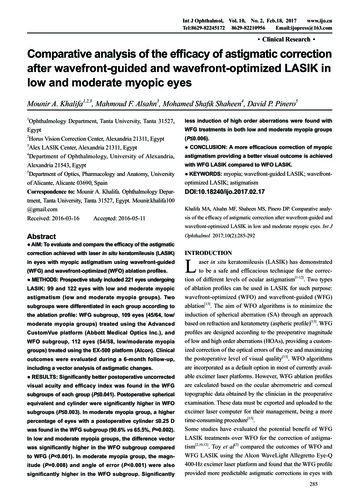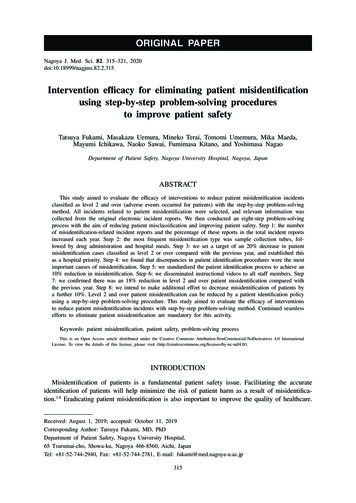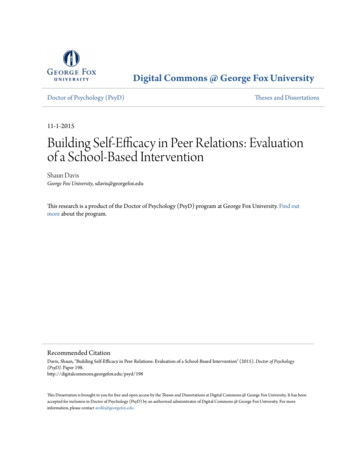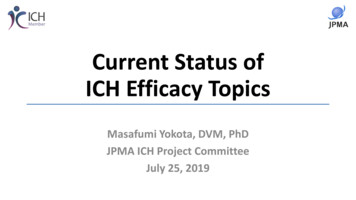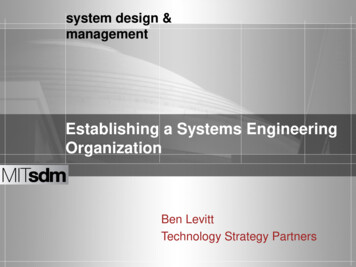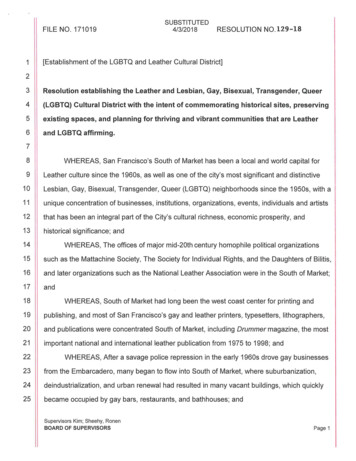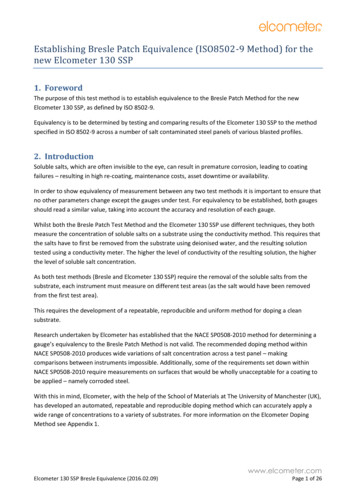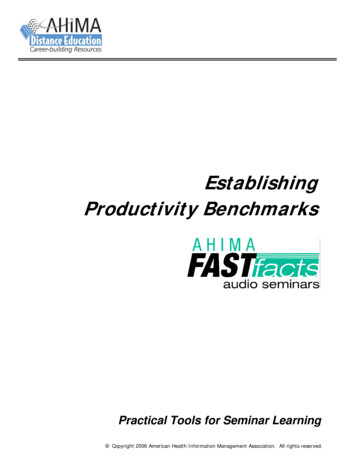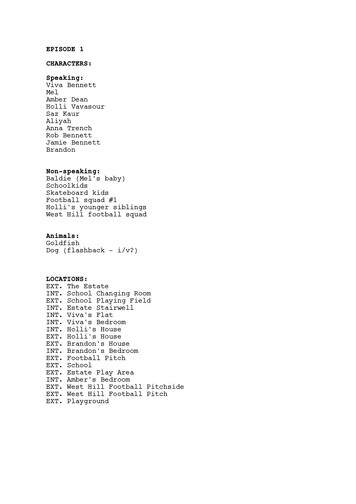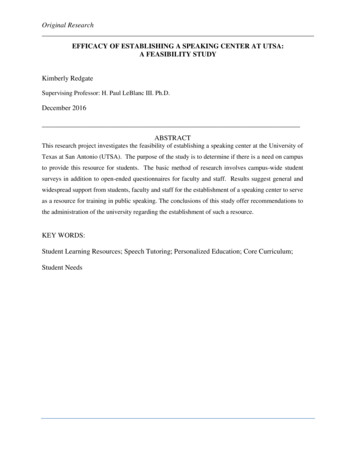
Transcription
Original ResearchEFFICACY OF ESTABLISHING A SPEAKING CENTER AT UTSA:A FEASIBILITY STUDYKimberly RedgateSupervising Professor: H. Paul LeBlanc III. Ph.D.December 2016ABSTRACTThis research project investigates the feasibility of establishing a speaking center at the University ofTexas at San Antonio (UTSA). The purpose of the study is to determine if there is a need on campusto provide this resource for students. The basic method of research involves campus-wide studentsurveys in addition to open-ended questionnaires for faculty and staff. Results suggest general andwidespread support from students, faculty and staff for the establishment of a speaking center to serveas a resource for training in public speaking. The conclusions of this study offer recommendations tothe administration of the university regarding the establishment of such a resource.KEY WORDS:Student Learning Resources; Speech Tutoring; Personalized Education; Core Curriculum;Student Needs
considered, then my proposal might beinterpreted differently than intended and I wouldprobably not be involved at all.Over the summer, I recognized that with thespeaking center being my idea and wanting to beas involved as possible in its creation, a moredirect route to making it occur was needed.Further reflection revealed that the notion of aspeaking center as being necessary at UTSA wasbased solely on my opinion. I needed to find outif other students believed it would help them, too.After all, if students would not even visit thespeaking center, then there would be no point inits creation. I asked friends and coworkers abouttheir thoughts and received positive support forpursuing the idea.With this in mind, realization set in that I wasthe one who needed to take action towardbuilding a case for the creation of a speakingcenter at UTSA. Having just completed theConduct of Communication Inquiry course, I hadthe tools needed to start a research study andknew that incorporating a campus-wide survey ofstudents about their attitudes toward a speakingcenter being built at UTSA would hopefullysupport my argument. Even if it did not, Iintended to present at the Spring ResearchConference where the UTSA community couldlearn of the possibility of such a resource beingon campus. Maybe student demand/outcry mightbring it to life. The only way to know was tobegin a research study and find out. Furthermore,my research would still be on record in case it wasdecided in the future to take action towardcreating a speaking center.As an Honors student pursuing Highest Honors,I was still deliberating on a topic for my HonorsThesis. This speaking center idea meant so muchto me and I did not want to graduate withouttaking action, especially since I perceived thathaving such a resource on campus would benefitthe student population. With this in mind, Idecided to pursue a research study.I looked into how to get a research projectstarted at UTSA. Just to be sure that I was takingthe right steps, I contacted Alegra Lozano, theHonors College Assistant Director for StudentPrograms. She thought the project was a greatidea and recommended contacting Dr. AnnEisenberg, Associate Dean of the HonorsCollege, for advice.INTRODUCTIONThe idea for my Thesis began in Spring 2014while enrolled in a Conduct of CommunicationInquiry course taught by Dr. H. Paul LeBlanc III.For this course, we were to present our researchstudies at the end of the semester. Being atransfer student from Northwest Vista College(NVC), I assumed that UTSA would have thesame resources that my community college didand then some. One of the resources at NVC thatI frequently made use of was the NVC SpeechLab, which offered space to practice deliveringpresentations and receive constructive feedbackfrom a tutor. I always felt more confident aboutpresenting after visiting the Speech Lab.Since the Conduct of Communication Inquiryclass presentation was soon, I determined thatpracticing in the UTSA Speech Lab would bebeneficial, but soon found out that such a resourcedid not exist on campus. I spoke with Dr.LeBlanc about this, mentioning that there was nospace for me to practice or to receive feedback.This is when the idea of creating a speakingcenter at UTSA started. I told him how UTSAneeds to build this resource for students. Myassumption was that Dr. LeBlanc would be ableto put my idea into action since he is the Chair ofthe Department of Communication.I realized that although Dr. LeBlanc is theChair, taking action on behalf of one student’sidea would be impractical. After all, the voice ofone student out of the many thousands at UTSAwould be insignificant compared to the workneeded to accomplish the idea in addition to thework needed to be done as the Chair.A different avenue to express my idea to thosewho could implement change on campus neededto be found. I determined that the logical nextstep would be to write a proposal for building aspeaking center and then deliver this to the Officeof Development. Surely this office would be ableto bring a speaking center to fruition. After all,developing spaces on campus is what their officedoes.By this time, the Spring semester had nearlyfinished. I realized that even if I submitted aproposal, there was no guarantee that any actionwould be taken toward building a speakingcenter. It might very well just sit on someone’sdesk and never be read. If construction was2
Following Lozano’s recommendation, Icontacted Dr. Eisenberg, who responded with,“ this is a fabulous idea for a thesis project.” Iwas in shock that this idea could be considered asa thesis idea! Not once did I even imagine this asa possibility!Over the summer, everything fell into placetoward turning my idea into an Honors Thesis. Itis also the Honors College’s first feasibility study.Interestingly, the first person I expressed this ideato would become my Thesis Advisor – Dr.LeBlanc. Through the Honors College, I wouldbe the one who could implement change oncampus by means of the Honors Thesis.The process to beginning construction of mythesis involved multiple steps. The first stepinvolved discussion of the goals for this project,which were to demonstrate a need for UTSA tocreate a speaking center and then to write myHonors Thesis.The second step was to select two ThesisReaders. As my study is about demonstrating theneed for a speaking center, it was apparent thatmy Readers should have expertise in the area ofspeech. This made it only appropriate to haveThesis Readers who taught Public Speaking,since they would have advice on what should beincluded in my research. This line of reasoningled to finding my two Thesis Readers, ProfessorLaura Oliver and Professor Dale Davis.The third step involved investigating previousfeasibility studies to gain insight into how suchstudies are framed. Through analysis of multiplestudies, the need for justification of my own studywas clear. After all, this Honors Thesis seeks todetermine if there is indeed a need on campustoward creating a speaking center.JUSTIFICATIONFORmandated guidelines for university core curricula.Of particular interest to the researcher are thestate mandates that have been enacted to holdTexas colleges accountable for instilling studentproficiencies in written and oral communication.The University of Texas at San Antonio (UTSA)will be evaluated toward helping students reachthe oral communication skill set.The state recognizes that knowing how towrite effectively is a skill that college studentsneed for success in academia and aftergraduation. Students are expected to complete 6credit hours in Communication coursework aspart of the core curriculum. The State of Texasrequires that coursework cover “oral, aural,written, and visual literacy skills that enablepeople to exchange messages appropriate to thesubject, occasion, and audience” (The UTSA,“Core Curriculum Area Requirements”). AtUTSA those requirements are met in writingclasses only (WRC 1013/1023). To meet the oral,aural, and visual skills, the campus also providesa course option in the core curriculum for publicspeaking although it is not required for studentsto accomplish.To supplement in-class instruction, 96.2% ofTexas colleges, as compiled from the list onAppendix A, currently have outside-class writingresources for students with one institutionworking on providing a writing center. Theseresources are most commonly in the form ofcampus tutoring services. UTSA offers theneeded courses in Writing/English to meet corecurriculum requirements. The campus alsofeatures a writing program as well as offers anacademic writing tutoring service, The WritingCenter. UTSA is therefore an advocate ofencouraging this needed skill set for studentsthrough both in-class and outside-class academicresources.The state also recognizes that knowing how tospeak effectively to an audience is a skill thatcollege students need for success in academia andafter graduation.Recently, the state hasmandated that oral communication be included incourses in the core curriculum (Texas HigherEducation Coordinating Board [THECB], 2014).UTSA, however, does not require students to takePublic Speaking, but rather allows students to“learn” oral communication through oralspeaking assignments within other CoreAFEASABILITY STUDYThe State of Texas has expected competenciesof its four-year college students by the timecommencement arrives. The core curriculumrequirements for all Texas colleges reflect theseexpected competencies which are to be developedthrough classroom instruction. The State ofTexas recognizes the need to provide studentswith opportunities to develop particular skill setsfor their careers beyond graduation and has3
Curriculum classes. Public Speaking is aComponent Area Option (UTSA UndergraduateCatalog, 2014-2015). This does not reflect thesignificance of speech skills to current collegegraduates. Students are not expected to completeany credit hours in Speech coursework as part ofthe core curriculum other than as an option.To supplement in-class instruction, 15.4% ofTexas colleges, as compiled from the list onAppendix A, have outside-class speech resourcesfor students. To determine the prevalence ofspeaking center resources in the State of Texas, Iutilized the list of universities with undergraduatecommunication programs available through theNational Communication Association (NCA). Ilimited this list to include only the accreditedpublic institutions in the State of Texas offeringfour-year bachelor degrees in communication.This final list is provided in Appendix A.Information regarding the number ofundergraduate students and communicationmajors, as well as whether the school offered aspeaking center and/or writing center wasdetermined through contacting each collegeand/or reviewing their public information on theirwebsite.From this information, I was able to determinethat these resources are most commonly in theform of speech help centers or labs. Thefollowing schools in Texas have speech centers:Midland College, Texas Southern University,Texas State University – San Marcos, and theUniversity of Texas – Pan American. TheUniversity of Texas of the Permian Basin offers aCommunication Lab course. UTSA offers theneeded courses in speech to meet core curriculumrequirements, although as noted above it is notrequired. The campus does not offer outsideclass academic speech resources. Based on this,there is a potential need for a speaking center atUTSA.Compared to how writing skills are taught inclass and complemented through outside-classresources, speech resources for students arelacking at UTSA. Since students are expected tobe proficient in speech skills after graduation,there is a potential need for an outside-classspeech resource. This study will look at thefeasibility of providing a speaking centerresource outside the classroom to meet thispotential need at UTSA.METHODSThe study population for this study includescurrent undergraduate UTSA students, selectUTSA faculty and staff members, and selectcommunity college speech lab personnel. Myinstruments are surveys and open-endedquestionnaires.Invitations to students, faculty and staff fortheir participation in this study through surveysand open-ended questionnaires will be sentthrough email to include the link to the onlinedata-collection instrument. See Appendix B forthe email invitations. The consent form anddata-collection instruments will be accessedthrough clicking the link within the emailinvitation. See Appendix C for the consentform and survey for students. See Appendix Dfor the consent form and open-endedquestionnaires for faculty and staff.The survey for current undergraduate studentscomprises questions that will measure studentopinion about a speaking center being developedon campus as well as predicted student use of thecenter. These questions were developed throughanalysis of six feasibility studies that wereconcerned with the development of collegeprograms (see Appendix E). I looked at whatwere the questions that guided the studies, howthey were being asked, and if the questionappeared in more than one study.The Office of the Registrar sent a mass emailrequest for participation in a survey toundergraduate students. Due to the possibilitythat students may request their email not be usedfor any business other than official UTSAbusiness, or the possibility that email addressesmay be out of date, a total number of emailrecipients is not known to the researcher.However, it is believed the email was sent to amajority of the total undergraduate studentpopulation. A group of 148 undergraduatestudents at UTSA responded to the survey by thecut-off date. The group of respondents consistedof undergraduate students ranging in age from 18to 61 with a mean age of 23 (sd 7.54). Of the148 participants, 64% were female and 36% weremale.Table 1 below shows the ethniccharacteristics of the study subjects.Table 14
Categorization and percentage of ethniccategories based upon open-ended responsesto ethnicity self-identification swhite,Caucasian, whitenon-Hispanic,Caucasian European39.3%American,NorthernEuropeanHispanic white,MexicanAmerican, whiteLatino, ana, LatinaAsian, MiddleEastern, AsianIndian, Indian,AsianFilipino, Asian11.0%American,ChineseAmerican, Arabother, AfricanAmerican, black,Othermore than 211.0%races listed,Native AmericanJustification for the ethnic categories is based onthe number of options that were received in thesurvey. As the question for how each studentidentified their ethnicity was open-ended,categories were chosen based on the number ofrecorded responses for each category. Thecategory of “Other” was chosen because therewere multiple ethnicities that were received on amuch smaller scale than the Caucasian, Latino, orAsian categories and were thus too small forcomparison purposes.Theopen-endedfacultyandstaffquestionnaire comprises questions that exploredopinions about the need for public speakingtraining based on their academic area ordepartment as well as their predictedrecommendations of using a public speakingtutoring service for their students if it wereestablished in UTSA’s Tomás Rivera Center, anacademic resource center created for all students.A grounded theory approach was utilized touncover themes in the open-ended data (Morse &Richards, 2002).The faculty and staff sample included forparticipation in open-ended questionnaires wasselected among campus departments to includekey members of administration within the JohnPeace Library, the Tomás Rivera Center, and theCenter for Student Professional Development inthe College of Business. Also selected for openended questionnaires were the administrativecoordinators of the two local Alamo CommunityCollege District campuses that feature speakingcenter resources for students – Northwest VistaCollege and San Antonio College. See AppendixF for the list of interviewees.The researcher’s faculty mentor sent a massemail request for participation in an open-endedquestionnaire to the faculty and staff listed inAppendix F. A group of 12 faculty and staffresponded to the open-ended questionnaire by thecut-off date.RESULTSTo determine if, and if so, how studentsperceived a need for a speaking center at UTSA,the survey data were analyzed for strength ofagreement. Additionally, Pearson Productmoment Correlation tests were utilized todetermine if there were any significantrelationships between responses.Class HelpSeveral items on the survey were designed tomeasure student perceptions on the help that aspeaking center might provide for their classes.Students seemed to be interested in how aspeaking center would help him or her and helpwith class work. Results indicated that studentsperceiving that tutoring in a speaking centerwould help them individually is positively relatedto perceiving that a speaking center would helpwith classes [r .701, p .001, N 148].Additionally, results indicated that studentperception that a speaking center would help with5
classes is positively related to intention to use aspeaking center often if it were established [r .714, p .001, N 148]; and perceiving thatestablishing a speaking center would help withclasses is positively related to the perception thatestablishing a speaking center would address anexisting problem [r .604, p .001, N 148].Students also reported that they perceived aspeaking center would increase retention andenrollment in classes. Results indicated studentsperceiving that a speaking center would increasestudent retention is positively related toperceiving that a speaking center would helpstudents [r .634, p .001, N 148] as well asperceiving that establishing a speaking centerwould help further the campus mission waspositively related to perceiving that it wouldincrease student enrollment [r .527, p .001, N 148]. Students also reported perceiving thatfaculty would benefit from having a speakingcenter established due to an increase inenrollment. Results indicated students perceivingthat a speaking center would increase studentenrollment is positively related to perceiving thata speaking center would help faculty [r .560, p .001, N 148].were established. Results indicated studentshaving speech anxiety were likely to feeluncomfortable giving presentations [r -.612, p .001, N 148], consequently intending to use aspeaking center if it were available [r .313, p .001, N 148].Relationship between a Speaking Center anda Writing CenterSeveral items on the survey were designed tomeasure student perceptions on the helpfulnessand perceived benefits of a speaking center and awriting center as well as any relationship betweenthe two centers. It was found that students lookedat the big picture for the UTSA campus and itsstudent population when considering theestablishment of a speaking center. Resultsindicated that the perceived helpfulness of aspeaking center to students is positively related toperceiving that a speaking center would addressan existing problem [r .664, p .001, N 148]and would help further the campus mission [r .746, p .001, N 148]. A relationship was alsofound between the individual student perceivingthat both a speaking center and writing centerwould be helpful and there was an intention to usethese types of centers was identified. Resultsindicated that the student’s perception that aspeaking center would help the individual studentis positively related to intention to use a speakingcenter if it were made available [r .756, p .001,N 148]; the student’s perception that a writingcenter would help the individual student ispositively related to intention to use a writingcenter [r .705, p .001, N 148]; and thestudent perception that a writing center wouldhelp them individually intention to use a speakingcenter if it were established is positively relatedto intention to use a writing center [r .436, p .001, N 148].To determin
four-year bachelor degrees in communication. This final list is provided in Appendix A. Information regarding the number of undergraduate students and communication majors, as well as whether the school offered a speaking center and/or writ
